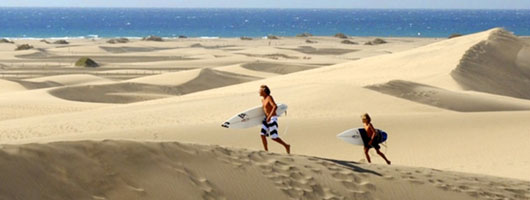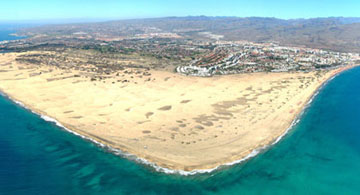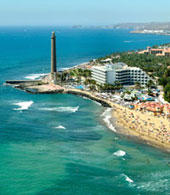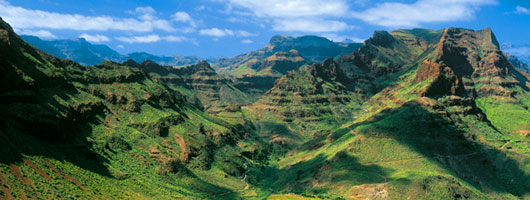The Municipal Town of San Bartolomé de Tirajana is situated at a distance of 54 kilometres from the capital, Las Palmas de Gran Canaria. This municipality is the biggest in Gran Canaria. Its mountainous landscape alternates with deep gullies, which extend towards the beautiful beaches of its coastal region.
The municipality of San Bartolomé de Tirajana combines beach and mountain tourism. The distance from the coast to the highest point of San Bartolomé is 40 kilometres. In the old quarter of the village, known as Tunte, stands the Church of San Bartolomé de Tirajana, consecrated in 1922. This church has a basilica floor-plan structure divided into three naves. Here we must highlight the Main Altarpiece, a work of art dating from 1922 by the master artist Lino Feo Ramos. The central niche of the altarpiece is occupied by the effigy of San Bartolomé (Saint Bartholomew), acquired between 1783 and 1787.

Nevertheless the tourist interest of the municipality is centred primarily on the coast, specifically in the area of Maspalomas, where one can find the moving Dunes, the Palmeral (Palm Tree Reserve) and the Charca (Pool) of Maspalomas, all catalogued as areas of Special Natural Reserve since 1994. These areas form a group of singular geomorphic, panoramic, botanic and zoological value, unique in the Canarian archipelago.
The Area of Dunes, a great mass of golden sand distributed in irregular forms, occupies a surface area of 4 square kilometres and is the foreground to a beach which is 5.6 kilometres long; this beach recieves the name of Playa del Inglés y Maspalomas.
Also on the coast and at the beginning of Maspalomas Beach, on its western vertex is situated the Maspalomas Lighthouse. The projected construction by Juan León y Castillo has a height of 60 metres.


The principal tourist centres that span the coast of San Bartolomé de Tirajana are formed by hundreds of hotel establishments, with an interesting and very wide range of Spa & Wellness Centres, combined with large commercial centres, a great 14,000 square meter multifunctional congress and conventions centre, two golf courses, entertainment centres and theme parks open 365 days of the year. San Agustín, Playa del Inglés, Maspalomas and Meloneras offer the visitor enjoyable seafront beachwalks from where one can view the extraordinary landscapes and beautiful sunsets. And to complete the walk, the visitor might like to visit the archaeological site of Punta Mujeres, an architectural gem of thousands of years of antiquity connected with the domestic architecture of the early inhabitants of the island, the Canarios.
The middle and mountain range areas of the municipality are formed by abrupt steep mountains and striking gullies such as Tirajana and Arguineguín, which limit the municipality to the east and west. In this municipality we also find the gullies of Fataga, Los Vicentes, La Data, or the Chamoriscan Gully, all of which spill out into Maspalomas and will not leave the visitor indifferent.

The capital of the municipality is called “Tunte”, the place receives its name from the settlement of an aboriginal town of the same name, where after the conquest, various settlers of hispanic origin settled. Tunte is found at the foot of the Morros del Pinar and next to the bed of the Barranco de Tirajana (the Tirajana Gully), at an altitude of 890 metres. Its priviledged position in the centre of the Caldera de Tirajana (the Tirajana Crater) has made it the main crossroads for communication between the north and south of Gran Canaria. Tunte justifiably boasts being the ideal place for the practise of hiking. In the village centre diverse architectural styles mix, evidencing the passage of history. One of the most traditional and emblematic buildings of the village is the Church of San Bartolomé.
For greater tourist information on San Bartolomé de Tirajana we recommend you visit the Tourist Offices of the municipality.